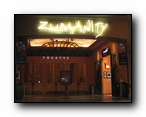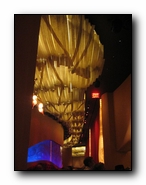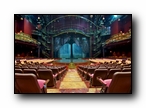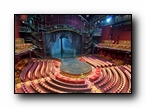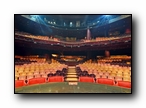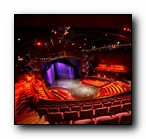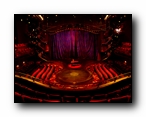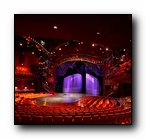
![]()
[ You are here: Grand Chapiteau | Creations | Zumanity | Scénographie ]
Création
Expérience
Réserve RétireOdyssey
A provocative cabaret-style production with a Cirque du Soleil twist, Zumanity blends playful innuendo with daring eroticism while emphasizing a multicultural approach to the disciplines of dance, movement, acrobatic techniques, costumes, and music. Contortion, driving salsa music, fire-eating, uninhibited African dance, tango, waltz, and passionate flamenco all speak the same language of excitement and desire. With Zumanity, Cirque du Soleil takes a bold new direction, exploring the full spectrum of human sexuality and intimacy to create a mosaic of love in all forms and from all perspectives. The seduction takes place in the 1,261-seat Zumanity Theatre, a cozy space custom designed to meet the unique demands of the show, featuring seating options ranging from a romantic duo sofa for two to a solitary cabaret stool or a traditional theatre seat. Let's explore that space, shall we?
Every new Cirque du Soleil show starts with a blank canvas, so it is fitting that the 64,000 square-foot space housing Zumanity would be completely stripped bare. The venue, the New York New York Hotel Casino Theatre, was taken back to the shell walls and a completely new theatre and lobby environment was created in its place. All of the existing interior architecture, including the theatrical systems, seating, and infrastructure were completely demolished, leaving the shell of the space. "Everything was destroyed," says Roy, referring to the previous theatre on the site. "Not even the ceiling remained." Auerbach•Pollock•Friedlancer were the theatre consultants for the project, collaborating with Marnell Corrao Associates, the MGM/Mirage Design Group and Cirque du Soleil on the design of the theatre renovation and the theatrical systems. The firm advised on all aspects of theatre design, from the room configuration, layout of public spaces and backstage support facilities, seating and audience circulation, to the detailed development of the technical systems, including the stage machinery and its rigging and automation, the theatrical lighting control and the sound, video and communications systems, changing the theatre space from a traditional proscenium stage to a long projecting thrust stage with an intimate surrounding seating configuration. All for about $50 million US dollars (the show cost another $15 million). This is not an ordinary theatre in any sense. Discreetly tucked away in a cozy corner of the bustling New York-New York Casino, just around the corner from "Greenwich Village" lays the Zumanity Theatre entrance, box office and gift shop. The elegant art nouveau style of the theatre contrasts sharply with the campy Disney- does-New York City look of the casino. The box office windows, gift shop gates and theatre doorway are all ornamented with curvaceous metal trimmings. The lush European décor is more than a hint of the sensuality within the theatre. The lobby undulates in waves of red and gold, with a carpet pattern of rippling muscles, one wall suggesting laced bodices (from svelte to zaftig), and another of tufted red velvet with some of the buttons replaced by glowing peepholes. When you peep, you see sensual images and hear a sexy soundtrack via small American Technology Corporation HSS loudspeakers that have just one degree of dispersion (listen carefully in the restrooms as well). In what Roy calls "the Amsterdam window, like in a red-light district," performers welcome guests seductively. A bathtub of popcorn and a bed are tucked in dark corners. Chandeliers look like glowing ovaries or perhaps breasts. "These are provocative flashes in the lobby. They prepare you for the language of the show," he says. Once inside, you're immersed in a playfully exotic environment.
An intimate space, not a single seat is further than 66' from the long thrust stage that penetrates the audience. The carpet is based on a painting of nudes, and the seating includes love seats for two and solo cabaret stools as well as traditional theatre seats, all upholstered in warm shades of red, gold, burgundy, and rust. "Everything makes a statement," says Roy, pointing out that the curves of the balcony fronts, the colors in the room, the curving stairs, and the shape of the proscenium are meant to be fallopian, rather than phallic, emphasizing the power of women. The principal scenic elements, The Waves, are two motorized pairs of Lexan panels that move via a system of pins traveling in a track. "The Waves can rotate in both directions to create all kinds of configurations," says Roy, who created one space that changes throughout the evening. "You can change the geography of the space, from wide open to a narrow little corridor where the audience is the voyeur looking into a window or through a facade." To create a frosted, art nouveau quality of milk glass, the Lexan was sand blasted and varnished. "Light and projections look great on the panels, but they still have a translucent quality so you can see the artists behind them," says Roy. The patina can be removed if Roy decides to create a window, or a peek into a shower. A curtain 150' long × 44' high was made by taking old fashioned lace and expanding the pattern into multiple panels. Roy notes, "a combination of contemporary automation and an old Italian Baroque technique of counterweights is used to make the lace opening in various ways, including moving like fingers pulling up a skirt or opening like a flower." Behind the lace is a mirror made of 4' × 4' panels of Lexan with 65% semi- translucent film. "It can be a perfect mirror, or you can use light to see through it and play at voyeurism," notes Roy. Metallic laser projection material creates a smaller drop hung at the center of the stage. "This absorbs light beautifully," says Roy. "All the colors of the spectrum." Natacha Merritt, photographer and author of the erotic website and book Digital Diaries, created the projections on the waves (and in the lobby peepholes). "She did photo shoots during the rehearsals, and her images are like a microscope zooming in on the performers. You might see a nose, or an arm, or just a body as the background. It's subliminal," says Roy. "They are an artistic way to see the body, sometimes in color or black and white, which can be more realistic than color." Projectors are by Digital Projection. A new thrust stage was designed to the scenic design specifications of the production, incorporating the machinery supporting the show's artistic requirements. A 21' diameter turntable in the center of the thrust stage is capable of high-speed rotation. A 6' diameter, two-stage pylon lift/turntable is located within the main turntable. The lift extends to 10' above the stage from trap room level at very high speed. This unit is keyed to the main turntable rotation speed and position, and is capable of independent rotation as well. The center stage area incorporates a high-speed slip stage that retracts within the floor, opening to the trap room below. Upstage of the turntable, a main stage lift operates at high speed, filling the center of the thrust stage area. Two flanking slip stages also open to the trap room and are filled with additional two high-speed lifts. Traps were designed into the stage deck for performer and scenery access and also accommodate a show floor for Cirque du Soleil's tracked scenery. JR Clancy built and installed the traps and turntable, and installed the motorized spot lines for rigging that were built by Stage Technologies. Additional acrobatic rigging was designed and implemented by Cirque du Soleil's in-house crew, under the direction of Jacque Paquin. Two smaller lifts, called the "chick" lifts, are located stage right and stage left in front of the proscenium. The musicians perch on a curved bridge that sits above the proscenium and adds to the art nouveau look of the theatre. "The bridge lowers to bring the musicians closer to the audience during a few numbers," says Roy. The fly tower was re-rigged with manual and counterweight assist linesets and working areas over the stage and audience were equipped to support motorized spot winches. All mechanized elements are controlled by a sophisticated machinery automation system. An automated computerized rigging and machinery control system manages the movement of all motorized devices. A total of 54 axes of motion control in the theatre coordinate the movement of lifts, turntables, slip stages, overhead rigging, trapezes and moveable scenic elements. Approximately 29 variable speed hoists are mounted throughout the theatre for automated effects. These, along with counterweight assist winches, were designed to facilitate a wide variety of performer and scenic effects. The automation system is interconnected by Ethernet data network, enabling random location of operation from either of two control consoles or portable hand held remote controllers.
Lighting designer Luc Lafortune added to the Paris cabaret feel of the room by using 90 Mole Richardson Molerama fixtures on curved catwalks (these "found" lighting instruments were recycled from EFX! at the MGM Grand). Solotech in Montreal provided the majority of the fixture inventory. Nol van Genuchten and Alexandre Tougas were assistant LDs, Janene Steele, head of lighting, and Hubert Tardif, moving lights programmer. He also placed Strand Fresnels in the wings, glowing softly, so as not to see the black velour masking behind them. "The final lighting choices were made rather late in the game," says Lafortune. "It's a titillating show so you can't give it away too soon. You have to tease, reveal shapes and contours but not the entire body right away." The nature of the show gave Lafortune almost carte blanche in terms of lighting styles. "I had the freedom to change from one act to another, moving from grand operatic lighting to visibly flashing moving lights and strobes to trash it out" he notes. "These genres might not normally go together in a book show." Lafortune's rig includes almost 300 ETC Source Four ellipsoidals of various sizes as well as 12 Source Four Zooms and 75 Source Four PARs, 12 Source Four PARnels, 50 Altman PAR64s, 24 James Thomas PAR46s, 12 James Thomas PAR36s, 38 Strand 2kW Fresnels, 12 Strand 5kW Fresnels, one Arri 6kW Fresnel, L&E MR16 strip-lights, 12 Altman single cell far cyc lights, eight Mole Richardson 5kW Skylights, and six Strand Beamlights. The automated fixtures include eight Clay Paky Stage Profile Plus SV units and 12 Vari*Lite VL2000 wash units. Followspots and HMIs are by Robert Juliat: four Ivanhoe 2,500W HMI followspots; plus five Juliat D'Artagnan 2,500W HMI Profiles. Other gear includes eight Martin Professional Atomic 3000 strobes, 12 Rosco Image Pros, four Lightning Strikes units, and over 75 Wybron Coloram II scrollers. The control system and network includes two Strand Lighting 550i consoles (one as a backup or to make changes and not disturb the show), a Strand 520 for special effects, and two Flying Pig Systems Wholehog II for the moving lights. Ten Strand SLD dimmer racks are located on the grid and in the basement. The Strand ShowNet systems includes 60 Ethernet nodes. "There are also four touchscreens," says Michael Lay, Strand's project manager. "These provide cue sheet data from the console for the stage manager. The screens interface with the 510i show controller.
Hundreds of projected photographic images are integrated into the set design of ZUMANITY. They are all the work of writer-photographer Natacha Merritt. In a former life she was a gymnast, which has given her a unique insight into the lives and concerns of her subjects, the cast of ZUMANITY. Merritt spent hours, days and weeks with the performers before shooting a single image. Instead, she observed them at rest and in motion, on stage and off. She worked with them, interviewing them in depth to explore their limits and gain their trust. Only when she had created the rapport she was seeking did she pick up her digital cameras and start shooting in the neutral territory of hotel rooms, rather than a studio. Her subjects were rarely asked to do anything they do in the show. They weren’t usually in costume, nor were they wearing stage makeup. "It was more about discovering something emotional, erotic, sexy in them," explains Merritt. "I wasn't interested in asking them to do something that wasn't them. I was only interested in shooting something that came from their heart. When they saw the first results and liked what they saw, we established a good relationship." Merritt accumulated a lot of pictures and selected them for the show afterward, rather than working to a predetermined agenda. She then layered each image with two or three others to create movie files to be projected onto 'The Waves,' two large multifaceted set elements that are in constant motion at the back of the stage. The result is an ever-changing kaleidoscope of faces, arms, legs, lips and torsos woven into a hypnotic collage that keeps time with the music and matches rhythm with the actions and contortions of the performers.
Deans opted for Meyer Sound self-powered speakers (six CQ1 and two CQ2) with four Turbosound 21" sub woofers for "a lot of kick. They push extra air into the room," he says. A dbx Sub-harmonic Synthesizer is used to drop any signal an entire octave, and as Deans says, "give the bass sound an extra oomph. It creates a physical feeling without deafening everyone." A Variable Room Acoustics System (VRAS) from Level Control Systems (LCS) makes the venue adjustable down to an acoustic piano. "Since there are so many sound levels in the show, and for certain numbers we wanted the audience to hear themselves applaud and laugh, we couldn't set a constant decay time," says Deans. VRAS offers the options of a small, medium, and large hall sound. There are also a variety of 29 microphones placed around the room, primarily from Sennheiser and Shure. Sixty Nexo PS-8 loudspeakers (powered by QSC amplifiers) are placed around the walls and on balcony fronts to provide surround sound and delay. Additional PS-8 boxes add extra high-end for the rear of the balcony, and 14 more are built into the edge of the stage. The audio control system features the new LCS Cue-Console II with new Cue-Station multi-platform software. The musicians wear Shure PSM700 in-ear monitors with belt packs. Processing equipment by TC Electronics includes Fireworx, Vocalworx, an M2000S effects processor, and an M4000 processor for streamlined reverb. There is also a backup signal system by Sierra Automation, which allows control of the show in real time in case of a glitch to the main system. "With ten shows a week, over the next ten years, there is bound to be a glitch, a brown-out, or a flash flood," says Deans. "The Sierra Automation cross-switcher is totally transparent to the audience. A Yamaha console then runs the show on a basic left/right mix. You go from a 497-channel mix to a two-channel mix, but it saves the show." Digital Clear-Com stations are linked via Cat5 cable and Ethernet nodes. The Ethernet system also allowed the sound team (Peter Hylenski was assistant sound designer) to work wireless throughout the venue via laptops that could plug in virtually anywhere. And in keeping with the theme of the show even some of the hand-held microphones are decorated as whips or ponytails. |


